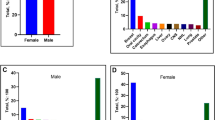Abstract
Cancer is a major burden worldwide but there are marked geographical variations in frequency and incidence overall. The aim of this study was to find the frequency and distribution of commonly occurring cancers in Kashmir, with particular emphasis on urinary bladder cancer. A total of 4,407 cases of histologically confirmed new cancer cases were registered at the Medical Records Department (MRD) of SKIMS from a period between January, 2005 and April 2010. Among 4407 cancers, 2,457 (55.7 %) were men and 1,950 (44.3 %) were women. Stomach cancer is the leading one with an average frequency of 19.2 % followed by esophagus and lung as 16.5 % and 14.6 %, respectively. Stomach (23 %) and lung (21 %) are the leading cancers in men while as esophageal cancer tops (18.3 %) in women followed by breast cancer (16.6 %). This distribution of cancer types is strikingly different from that in the rest of India where oropharyngeal cancer is most common form. Among urinogenital cancers, bladder cancer was observed to primarily affect Kashmiri population (5.9 %) followed by prostate cancer (2.1 %) and renal carcinoma (1.1 %). We conclude that Kashmir is a very high risk area of most commonly occurring cancers particularly cancers of gastrointestinal tract which comprise more than half the frequency of all the cancers.



Similar content being viewed by others
References
Garcia M, Jemal A, Ward EM, et al. Global cancer facts and figures 2007. American Cancer Society, Atlanta.
Ferlay J, Bray F, Pisani P, et al. GLOBOCAN 2002: Cancer incidence, mortality and prevalence worldwide. IARC Cancer Base No. 5.version 2.0. Lyon: IARC Press; 2004.
Boyle P, Levin B, editors. World Cancer Report 2008. Lyon: International Agency for Research on Cancer; 2008.
Mathers CD, Loncar D. Projections of global mortality and burden of disease from 2002 to 2030. PLoS Medicine. 2006;3(11):e442.
Nanda KA. Consolidated report of the population based cancer registries, incidence and distribution of cancer, 1990–1996. National Cancer Registry Program, New Delhi: Indian Council of Medical research; 2001.
World Health Organization. A decade of health development in SE Asia, 1968–1977. New Delhi: SEARO; 1978.
IARC. Schistosomes, liver flukes and Helicobacter pylori, IARC monographs, vol. 61. Lyon: IARC; 1994.
Kmet J, Mahboubi E. Gesophageal cancer in the Caspian littoral of Iran: initial studies. Science. 1972;175:846–52.
Yang CS. Research on oesophageal cancer in China: a review. Cancer Res. 1980;40:2633–44.
Warwick GP. Some aspects of the epidemiology and aetiology of esophageal cancer with particular emphasis on the Transkei, South Africa. Adv Cancer Res. 1973;17:81–229.
Siddiqi M, Preussmann R. Oesophageal cancer in Kashmir—an assessment. J Cancer Res Clin Oncol. 1989;115:111–7.
Malhotra SL. Geographical distribution of gastrointestinal cancers in India with special reference to causation. Gut. 1967;8:361–72.
Tricker AR, Siddiqi M, Preussmann R. Occurrence of volatile N-nitrosoamines in dried chillies. Cancer Leu. 1988;38:271–3.
Siddiqi M, Tricker AR, Preussmann R. The occurrence of preformed N-nitroso compounds in food samples from a high risk area of esophageal cancer in Kashmir, India. Cancer Leu. 1988;39:37–43.
Waterhouse J, Shanmugaratnam K, et al. Cancer incidence in five continents. Lyon: IARC; 1982. p. 390–7. IARC Scientific Publication no 42.
Siddiqi M, Tricker AR, Preussmann R. Formation of N-nitroso compounds under simulated gastric conditions from Kashmir food stuffs. Cancer Leu. 1988;39:259–65.
Parkin DM, Whelan SL, Ferlay J, et al. Cancer incidence in five continents, vol. VII, International Agency for Research on Cancer (IARC). Lyon: IARC; 1997.
Koul PA, Koul SK. Epidemiology of lung cancer in Kashmir Valley. Annuals of Thoracic Medicine. Thesis submitted to the Sheri Kashmir Institute of Medical Sciences University; 2007.
Khan NA, Firafroz, Lone MM, et al. Profile of lung cancer in Kashmir India. A five year study. Indian J Chest Dis and Allied Sci. 2006;48:185–8.
Behera D, Balamugesh T. Lung cancer in India. Indian J Chest Dis and allied Sci. 2004;46:269–81.
Ernest LW, Kiychiko M, Edward JB. The epidemiology of lung cancer. JAMA. 1970;213:2221–7.
Wynder EL, Munskinski M. Tobacco and alcohol consumption in relation to the development of multiple primary cancers. Cancer. 1977;40:1872–8.
Taylor J, Piper DW. The carcinogenic effect of cigarette smoke. The effect of cigarette smoke on human gastric mucosal cell in organ cultures. Cancer. 1971;39:2520.
Arya SN, Kumar R, Snajay A. Hazards of smoking. Indian Med Assoc. 1991;89:98–100.
Karim-Kos HE, De Vries E, Soerjomataram I, et al. Recent trends of cancer in Europe: a combined approach of incidence, survival and mortality for 17 cancer sites since the 1990s. Eur J Cancer. 2008;44(10):1345–89.
Clavel J. Progress in the epidemiological understanding of gene environment interactions in major diseases: cancer. C R Biol. 2007;330:306–17.
Arshad AP, Zafar S, Roohi R, et al. Activated H-ras gene mutations in transitional cell carcinoma of urinary the bladder in a Kashmiri population. Tumori. 2010;96:993–8.
Coleman MP, Esteve J, Damiecki P, et al. Trends in cancer incidence and mortality, International Agency for Research on Cancer (IARC), Scientific Publication 121. Lyon: IARC; 1993.
Neve A. Kangri-bum epithelioma in Kashmir. Ind Med Gaz. 1990;35:81–3.
Neve EF. Kangri bum cancer. Br Med J. 1923;2:1255–6.
Neve EF. Kangri-bum cancer. Ind Med Gaz. 1941;76:138–40.
Shera AH, Bhan BM. Clinicopathological behavior of Kangri cancer. Ind J Surg. 1986;48:233–8.
Sanyal B, Shastri SR, Hakim A, et al. A clinical profile of skin cancer from Kashmir valleywith special reference to “Kangri” cancer. J Clin Radiother Oncol. 1989;4:31–6.
Treves N, Pack GT. The development of cancer in bum scars. Surg Gynecol Obstet. 1930;51:749–82.
Perin N, Notani. Global variation in cancer incidence and mortality. Current Science. 2001;81(5):465–74.
Acknowledgement
I acknowledge the assistance of the Department of Medical Records, SKIMS particularly Mohammad Yousuf who helped me in collection of the data and Ms Nighat Khan, Mr Niyaz Azad and Mohsin Saleem for their valuable inputs.
Author information
Authors and Affiliations
Corresponding author
Rights and permissions
About this article
Cite this article
Pandith, A.A., Siddiqi, M.A. Burden of cancers in the valley of Kashmir: 5 year epidemiological study reveals a different scenario. Tumor Biol. 33, 1629–1637 (2012). https://doi.org/10.1007/s13277-012-0418-z
Received:
Accepted:
Published:
Issue Date:
DOI: https://doi.org/10.1007/s13277-012-0418-z




